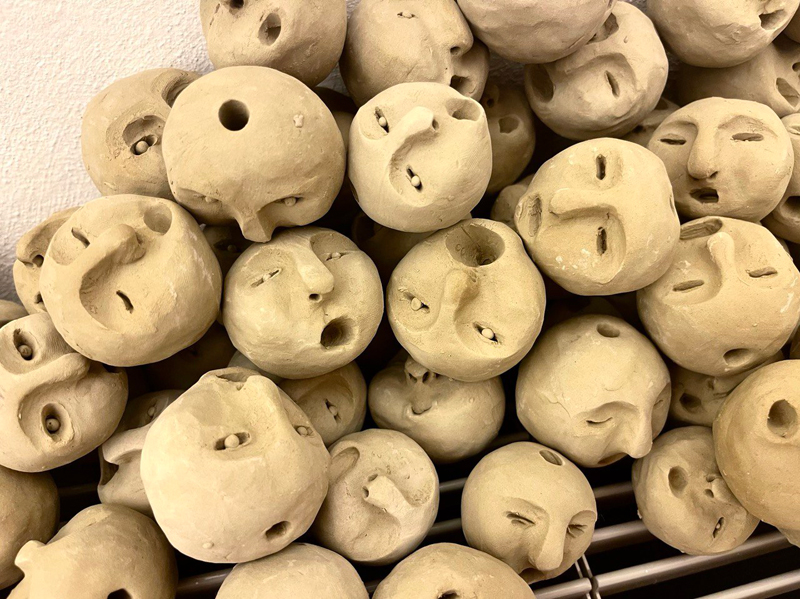Saptarshi Ghosh
The ongoing conflict in Ukraine has had repercussions around the globe. From economic upheavals and battle lines being drawn between major international powers to a refugee crisis impacting thousands, the Russia-Ukraine conflict demonstrates why war in today’s age is a bad idea. However, cutting through the chatter of international responses, one cannot imagine the horrors ordinary people in Ukraine are subjected to, living under constant mortal fear. Reports of civilian areas being bombed and rampant loss of innocent lives have become regular. With the conflict entering its second year, the number of casualties has reached alarming proportions, on both Ukrainian and Russian sides.
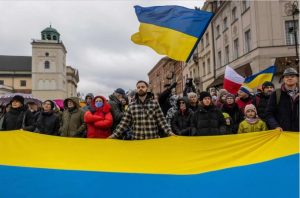
Courtesy- Foreign Policy
Amidst the bleakness, what shines as a ray of hope is the steadfastness with which Ukrainians have responded to the infiltration. Russia, with all its military might, has not been able to vanquish the indomitable spirit of ordinary Ukrainians, who are infused with a whole-hearted commitment to defend their nation at all costs. And as always, art has turned into a potent tool of protest and resistance against the violence being unleashed. Ukrainian artists have taken up the paint brush to engage with and respond to the violence and trauma of war, as well as to explore broader themes of identity, memory and cultural heritage.
Viktor Kudin
One of the most notable Ukrainian artists is Viktor Kudin, who has gained international recognition for his striking and haunting images of the conflict zone. Originally from Luhansk, he has documented the war, capturing the devastation and displacement of civilians as well as the destruction of buildings and infrastructure. His work combines architecture and painting; his use of colour and composition creates a sense of both urgency and beauty.
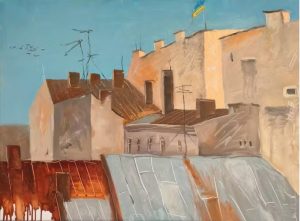
Courtesy: The Conversation
The war came as a huge moral shock to Kudin. And it has transformed his life ever since, like it has for all Ukrainians. Making art amidst such adversity is not easy. He explains how his inspiration has been adversely affected. Through art, he tries to understand his “intense” emotional response to the war. “I can’t live with such intense feelings,” he says. “I want to give names to these forces running through me. I want to understand them.”
Denys Metelin
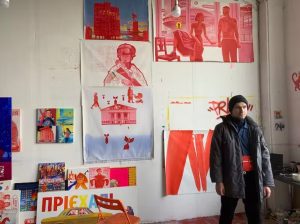
Courtesy: The Conversation
Another artist making impactful art is Denys Metelin, who originally hails from Crimea. Working primarily in street art, Metelin’s work explores the psychological impact of the war on individuals and communities, particularly the ways in which trauma and loss are expressed and processed through art. He often incorporates symbols associated with the Soviet Union, only to subvert them. Celebration of the heroic efforts of the Ukrainian military is another common theme in his works.
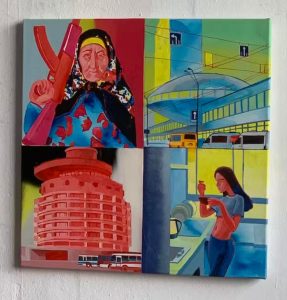
Courtesy: The Conversation
Varvara Lohvyn
Varvara Lohvyn is a prominent woman artist whose work explores the intersection of gender, conflict and identity. Her mixed media installations incorporate elements of traditional Ukrainian textiles, such as embroidery and weaving, with contemporary materials and techniques, thereby creating a dialogue between the past and present. Lohvyn’s work also highlights the role of women in the conflict, particularly as caregivers and activists, and the ways in which their contributions are often overlooked or marginalised. Recently, Lohvyn undertook a project wherein she painted the black metal impediments set up to ward off tanks in an effort to beautify them.
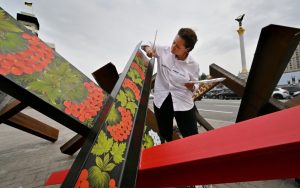
Courtesy: Radio Free Europe
Oleksandr Grekhov
Oleksandr Grekhov is another artist whose work engages with themes of memory, history and trauma in the context of the war. His illustrative graphics, extremely popular on social media, explore the ways in which war disrupts and transforms personal and collective narratives. Grekhov is also a strong advocate for the rights of the queer community in Ukraine. Through his vibrant illustrations, he voiced the anxieties of the queer soldiers fighting for their country, urging the Ukrainian government to recognise same-sex marriage and empower queer couples.
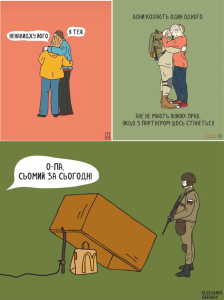
Courtesy: Ukrainer.net
Olha Wilson
Olha Wilson’s images focus on the experiences of those, particularly animals and children, who have been affected by the war. They highlight the resilience and humanity of those living in the conflict zone. Wilson’s work provides a powerful counter-narrative to the often-dehumanising representations of war in the media and popular culture.

Courtesy: war.ukraine.ua
Recently, Wilson has been creating portraits of victims of the war upon request, for free. People who have lost a family member, friend or pet in the war often write to her, requesting her to illustrate their memories of that person or animal. Wilson often receives requests to draw pets. In times of violent conflicts, animal casualties often slip under the radar. Thankfully, many animal activists are working in Ukraine to provide care and shelter to affected or injured animals.
Captured House exhibition
The Captured House exhibition is a touring art exhibition, which is part of Ukrainian diplomacy drive to raise awareness of the humanitarian crisis in Ukraine. The exhibition showcased over 100 works, including paintings, sculptures, installations, photographs and videos, providing a comprehensive overview of the breadth and depth of the emerging art in response to the Russia-Ukraine conflict. The exhibition, which took place in cities like Berlin and Brussels, also included panel discussions, workshops and performances, creating a dynamic and interactive space for artists and audiences to engage with the themes and issues raised by the artists.
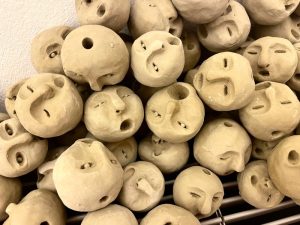
Courtesy: Berlin Art Link
One of the most harrowing works on display is by Daria Koltsova, whose intention is to count every child who has lost their life in the war. She carves tiny heads made of clay, each of which stands for a child killed in the war. Another interesting piece is a steel door from a bombed house in Irpin. The residents of the house had abandoned it and escaped to Kyiv. Thankfully they were able to evade death since their house was turned to rubble when the Russians bombed the city. The only thing left standing was the steel door.
In conclusion, the art being produced by contemporary Ukrainian artists is a powerful and necessary response to the ongoing conflict in eastern Ukraine, allowing them to engage with and express the complex realities of war through a variety of media and approaches. It challenges us to confront the human cost of war and imagine new possibilities for healing and resilience in the face of violence and trauma.
Bibliography:
- https://theconversation.com/ukraine-diaries-art-in-the-face-of-the-war-184199
- https://war.ukraine.ua/articles/war-in-ukraine-through-visual-arts-when-a-picture-is-worth-a-thousand-words/
- https://www.theguardian.com/world/2022/jul/31/ukrainian-war-art-exhibition-arrives-brussels-captured-house
- https://www.wilsoncenter.org/collection/arts-war-ukrainian-artists-confront-russia

